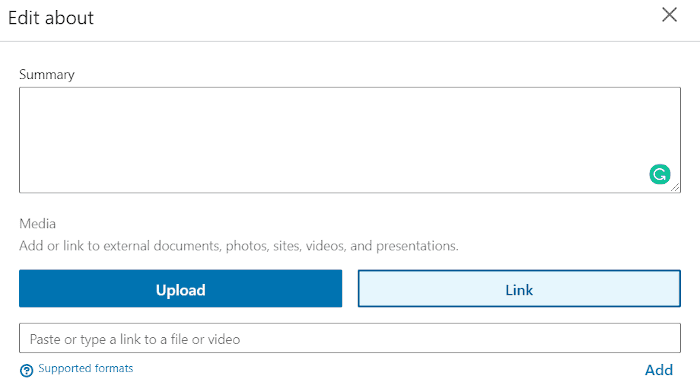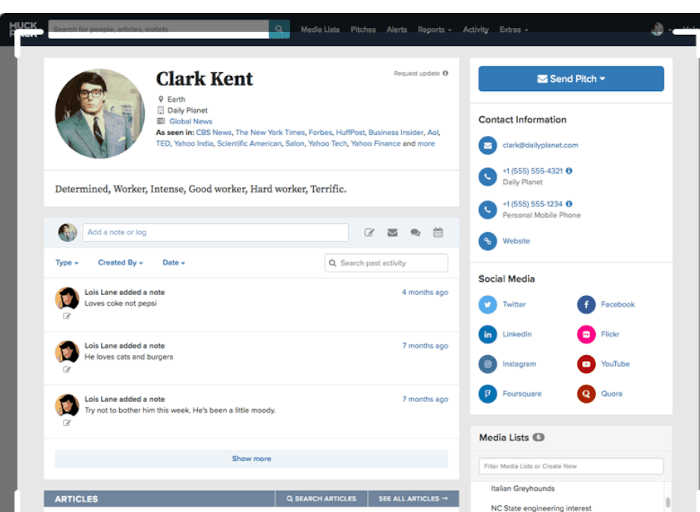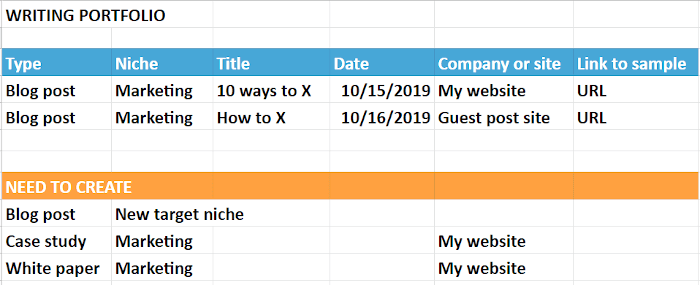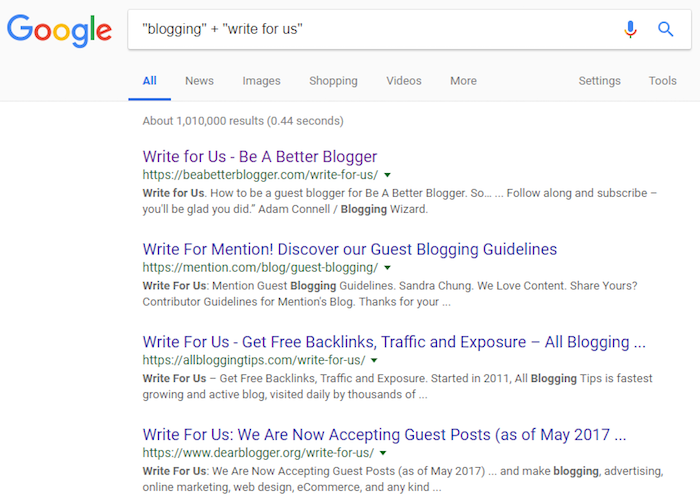Your writing portfolio is a critical tool in your marketing arsenal.
After all, it’s the first thing a potential client will want to see. And a kick-butt writer portfolio can do most of the selling for you.
As a freelance writer, you know this, but where do you start?
Well, there are three things you need to know to create an online writing portfolio that wins clients:
- What online portfolio sites will showcase your writing samples?
- Tips for a writing portfolio published on your own website.
- Ideas for building a catalog of writing samples.
Let me walk you through these. Ready?
8 Portfolio Sites to Showcase Your Writing Samples
Digital portfolio sites allow you to create attractive and professional-looking portfolios while handling the technology and design concerns for you.
Using these sites for your freelance writing portfolio frees you to focus on creating more samples. This is especially crucial for newbies.
As a bonus, two of these sites may even help you find writing jobs.
1. Clippings.me
Creating your online writing portfolio with Clippings.me is fast and easy. During the account setup process, you can even connect to your Twitter account to import your bio and avatar.
You can customize the look and feel of your portfolio by choosing one of the provided theme pictures or by using your own picture. Your professional writing portfolio will show your name, title, bio, and will display up to 10 clips (free version).
Here’s one of the writing portfolio examples from Clippings.me:
Pros of Clippings.me
- An easy and quick way to show off your freelance portfolio pieces. Paste in the URL of your clip, and the date, publication, title, and image populate automatically.
- Support promises to answer most questions within 24 hours.
- You can showcase your portfolio in their journalist directory.
Cons of Clippings.me
- The free version is limited to 10 articles.
- A spam-protected contact form is only available as a premium member. (The site warns against spam if you provide your email in your bio.)
Cost of Clippings.me
- Free for up to 10 articles. The premium package costs $9.99/month. Included features are unlimited samples, custom domain name, portfolio privacy (spam-protected contact form), and Google Analytics integration to measure views.
Clippings.me is a solid option for freelancers with less than 10 samples.
2. Pressfolios
Pressfolios states that it’s “the easiest way for journalists, writers, reporters, bloggers, public relations and other media professionals to backup their news stories, design a beautiful online portfolio website, and showcase their personal brand — no coding required.”
There is no free version, but there is a 14-day trial.
Pros of Pressfolios
- A clean page design containing three sections — a header, stories (your writing projects), and an About section.
- You can organize your stories by section (aka niche).
- Full-text backup of your stories (as part of the paid service).
Cons of Pressfolios
- Free for a 14-day trial only.
- You can only upload PDFs with the Pro version at $14.99/month.
Cost of Pressfolios
- 14-day free trial. The Lite version costs $9.99/month for up to 250 stories. The Pro version is $14.99/month and includes unlimited stories, privacy options, custom domain name, and allows you to upload PDFs.
This option is best for journalists and reporters as the concept of “stories” may not fit your writing niche, especially if you’re a copywriter.
3. Journo Portfolio
Journo Portfolio provides an impressive amount of options to design your writing portfolio. They boast of “hundreds of ways to customize your online portfolio.” Multiple themes, background images, colors, and fonts are available to choose from.
The site allows you to display a bio, social media links, PDFs, or any kind of multimedia file. You can also publish articles directly on the site.
Pros of Journo Portfolio
- Adding samples is easy —enter the URL and Journo Portfolio will autofill the date, publication, title, and image.
- You can have multiple pages in your portfolio, including Contact and About pages.
- You can sort samples into different niches either by using content blocks or by putting them on separate pages.
Cons of Journo Portfolio
- The number of customization options could be overwhelming.
- Your portfolio isn’t password-protected unless you select the Pro version.
Cost of Journo Portfolio
- The free version allows up to 10 articles. The Plus version is $5/month for unlimited pages and articles. The Pro version is $10/month and includes your custom domain name, article backups, a password-protected portfolio, and an HTTPS certificate.
The Pro version of Journo Portfolio is the closest thing to having your own WordPress website without worrying about web hosting, security, or backup.
4. Contently
Contently calls itself, “The complete content marketing solution.” Not only is it an online portfolio site for writers, but it’s also an online content agency.
Contently provides a single-page interface where you can display unlimited projects. You can display your picture, bio, links to social profiles, skills, niches, and even the URL of your writer website (if you have one).
Pros of Contently
- No limit on the projects you can upload.
- A rates database that allows you to see what clients are paying for various projects (information is uploaded by freelancers who work for the platform).
- The potential for writing work. It’s an active marketplace with reasonable pay, and clients include larger companies such as Google, Dell, and Walmart.
Cons of Contently
- You need at least 7 projects to be considered for brand work.
- LOTS of competition on the platform, so it will take time to be “discovered” for freelance writing gigs.
Cost of Contently
- Free
Once you set up your profile, you will have a professional-looking and free writer’s portfolio. Plus, you have the potential for writing gigs in the future.
5. Quiet.ly
Quiet.ly is an online content marketing agency that allows you to create a profile potentially leading to writing gigs.
Pros of Quiet.ly
- Potential for writing job leads.
- Active marketplace with clients such as Adobe, Slack, and Dell listed.
Cons of Quiet.ly
- No guarantee that you will be matched with a potential employer. It depends on your skills, niche, and the businesses searching for potential freelancers.
- You’ll be in direct competition with other freelancers.
Cost of Quiet.ly
- Free
Fill out your profile in detail, add relevant writing samples, and the Quiet.ly editors could match you with a prospective client who matches your interests and skill set.
Note: The option to create a public portfolio isn’t currently available. Unless you have very specific portfolio requirements, you should probably look elsewhere to meet your writing portfolio needs.
6. LinkedIn
Your LinkedIn profile is your freelance writing online resume. A link to your profile is often requested by potential clients (especially larger companies).
LinkedIn isn’t designed to be a writing portfolio, but you can use it as one.
Highlight your best samples by placing them in your Summary section, using the Upload File or Add Link options.
You can use the Experience section to list clients and provide links to the writing work you’ve done for them.
Pros of LinkedIn
- LinkedIn builds your visibility online. More than 30 million companies are on LinkedIn, and companies run searches to look for freelance writers whose skills and interests match their needs.
- You connect with people at companies you are interested in writing for and build relationships with them.
- You can use LinkedIn Publisher to publish (or repost) your work to prove your writing skills in a particular niche, and perhaps capture the attention of those in your network.
Cons of LinkedIn
- With LinkedIn, you don’t own your profile. You could lose all the work you put into building your connections if your account was blocked or banned.
- You need a niche prominently stated in your profile to help companies find you, or it will be hard to stand out.
Cost of LinkedIn
- It’s free to set up a profile.
Creating an enticing LinkedIn profile is an excellent way to connect with both prospects and clients, as well as other freelance writers.
7. Pinterest
Pinterest is a visual discovery engine. To design a writing portfolio, you’ll want to create a Pinterest business account complete with bio and a professional picture.
To use Pinterest, you first create or source images to represent your posts. Then use those images to create “pins,” which link to your post and can include your headline, author name, and post description.
These pins can be organized on boards, which act as containers for groups of pins. Using the right keywords or keyphrases is essential if you want your pins or boards to be discovered.
Pros of Pinterest
- It’s another way to expand your online presence (and help potential clients find you), and it’s free.
- You can create boards for each niche or keyword to make it easier for bloggers and other business owners to find you.
- A fun form of marketing if you enjoy creating or sourcing images.
Cons of Pinterest
- It’s not relevant for all niches. Look at popular boards to confirm whether or not your niche does well on Pinterest before you begin.
- Creating and/or finding images is the entire point of this platform, so if that doesn’t appeal to you, you may want to pass.
Cost of Pinterest
- Free to use.
Creating a writing portfolio using Pinterest can be fun if you enjoy working with images. At a minimum, enable the “Pin It” button for images on your writer website so your posts can be shared on Pinterest.
8. Muck Rack
Muck Rack is a PR software platform designed for journalists and PR pros. The platform is open to any writer; however, only verified journalists get a green badge to signify that they meet Muck Rack’s criteria.
This platform is dedicated to the profession of journalism. Since it is integrated with Twitter, it tracks what journalists are Tweeting about.
Pros of Muck Rack
- Automatically compiles articles and social media profiles, making setup easy.
- It provides full-text backups for your writing portfolio.
- You can track the impact of your work by using the “Who Shared My Link” tool to see social shares for your article, and the journalist who shared it.
Cons of Muck Rack
- Designed primarily for journalists.
- You’ll be signing up to receive PR pitches (although you can edit this in the settings).
Cost of Muck Rack
- Free for journalists.
This is a fantastic option for journalists. A benefit of using this site as a freelancer is you could sign up and then use the platform to find journalists to interview for your articles.
12 Tips for Portfolio Pages Hosted on Your Own Writer Website
The writing portfolio sites we just discussed can get you started, but eventually, you’ll want to create your own writer website.
Why?
Because with portfolio sites, you are only a renter, not an owner. Policies and pricing can change overnight. An ideal situation is to use these sites in addition to a writer website, which you own and control.
So how do you optimize a writing portfolio hosted on your own website? Follow these 12 tips:
1. Know Your Target Client and Desired Niche(s)
Select your writing portfolio samples with your ideal client and niche(s) in mind. Choose relevant samples that would appeal to potential clients and are in niches that you want to write in.
And in you include testimonials in your writing portfolio, be sure they come from reputable sources who represent your ideal target.
2. Limit Your Freelance Writing Portfolio Samples
Avoid overwhelming potential clients with too many choices. Provide enough samples to demonstrate your writing ability and to give a selection of options, up to three per niche. This is your writing portfolio, not a blog, right?
3. Choose Quality Over Quantity
Include only your best work, not every example of your work. Only showcase your best testimonials, not every attaboy or kudos you’ve ever received. And the same is true for awards and accolades — do include reputable writing contests you’ve won, but don’t go overboard.
4. Confirm That Your Writing Portfolio (And Website) Is Easy To Navigate
Make it super simple to find everything. To test this, ask a friend to open your website, and then find one specific piece of information on your portfolio page. Make any necessary changes based on their feedback.
5. Organize Samples By Type, By Niche, and Use Clear Descriptions
Make it easy to find samples by organizing them by type (posts, white papers, landing page copy, etc.) and by niche. Also, provide brief descriptions of your samples (and put on your copywriter hat where possible). For ghostwritten clips that lack your byline, add “ghostwritten” in the description to prevent confusion.
6. Keep Your Writing Portfolio Design Clean and Simple
Keep your design uncluttered, with no distractions, so your samples stand out. Use clear, easy-to-read fonts at least 14pt in size.
7. Don’t Display Entire Articles on Your Portfolio Page
Instead, provide links to the samples, and have the samples open in their own distraction-free pages.
8. Use Thumbnail Images For Each Writing Sample
Text-only links are okay but aren’t as compelling as images. Images help your samples visually pop on the page.
9. Use Plug-ins or Page Builders to Help You Design
These tech tools help you design a professional-looking portfolio. However, before you install a plug-in or page builder, confirm it has been recently updated. Also, check that it is compatible with both the latest version of WordPress and your theme.
As an example, the page builder Elementor (affiliate link) has an Image Box widget with impressive capabilities (and it’s free!).
10. Check It On Mobile And Tablets
Your writing portfolio may look beautiful on your desktop, but always double-check how it looks on tablets and phones. Confirm that text and images don’t get cut-off or distorted.
11. Keep Your Writing Portfolio Fresh and Up-to-Date
Check your links often, at least once a month. Also, replace older samples as you create new and improved ones — Google loves and rewards fresh content on your website.
12. Have a Clear Call-to-Action (CTA) On Your Portfolio Page
The whole purpose of your writing portfolio is to motivate potential clients to contact you. Make that next step easy. Either display your email address or a clickable button leading to a “Contact me” page.
How to Build Writing Samples for Your Freelance Writing Portfolio
So…
What if you complete the steps above, and your writing portfolio looks a bit, well, sparse? Solution: Build a list of strong writing samples.
Start with a spreadsheet and a strategy. This answers the questions of “what do you have, and what do you need?”
A spreadsheet (or simple Google Doc) provides an organized list of all of your published samples — one central location to track your work. Not only will this save you time, but it will show you at a glance what holes you may have in your strategy and what you need to create.
Here’s an example:
As a freelance writer, you need to prove that you have the writing skill to create the type of content your target clients are willing to pay for. Your writing samples provide this proof.
So let’s cover how to do this.
1. No Barriers To Entry: Publish Posts on Your Own Website
For newbies, this is the easiest way to get started. Plus, creating posts provides a benefit beyond proving your writing ability to clients. You also prove to yourself that you would enjoy writing in a particular niche.
If you want to break into new types of writing, you can create samples to demonstrate your skill. For example, if you want to add case studies to your writing services, create a fictional case study to show that you understand the form.
2. Money Well Spent: Hire a Copyeditor
The downside of creating samples on your own is that you don’t get the feedback you need to improve. Friends and family are helpful, but typically far too generous.
By hiring a copyeditor, you can learn where you make mistakes and improve your samples.
3. Smash Down the Wall: Take a Class
If you’ve been procrastinating or don’t know where to start, a course can be an excellent way to move forward. The best courses do more than provide information — they encourage you to implement what you’ve learned, and provide feedback.
Taking a course costs money, but it’s an investment in yourself as a writer.
4. Friendly Practice: Publish Posts on Medium
By posting on Medium, you can practice your writing skills in a friendly environment (plus, if you sign up for the Medium Partner Program, you could earn a little money on the side). Practice publishing regularly so you get used to your words being out in public.
SEO tip — publish your posts on your own website first, wait for at least two weeks, and then re-publish it on Medium. This way, the search engines index your site first.
5. Byline Power: Write Guest Posts
Write guest posts that allow you to include your author bio with a link to your writing portfolio. This is an excellent method to get published posts with your byline on it, critical for social proof and credibility.
Guest posting is typically unpaid, although there are exceptions. The focus here is on getting your first byline, and on creating samples for your portfolio.
Choose a blog that has a high level of credibility, is respected in your niche, or is where your target clients are likely to hang out.
If you aren’t sure where to begin, try Google:
Search for a niche or topic (in the screenshot example above, we used “blogging”) along with a relevant phrase (“write for us”).
Google will return a list of search results containing both terms/phrases.
If you find a good target, add it to your spreadsheet. Next, try a few different variations in Google:
- “blogging” + “guest post”
- “blogging” + “contribute”
- “writing tips” + “write for us”
- Etc.
Replace “blogging” and “writing tips” with your own niche/topic.
When you have a solid list of potential blogs to pitch, look at their popular posts, and the topics they cover. You need to know what kind of content they want, so do your research.
Read their guest posting guidelines and follow them when preparing your pitch.
Once one of your pitches is accepted, celebrate! Then be prepared to do your best work. After all, this post will be one of the building blocks in your writing portfolio.
Start Building Your Rockstar Writing Portfolio Today
Your writing portfolio is your main sales tool, the one that follows the adage, “Show, don’t tell.”
Imagine how you will feel with a strong writing portfolio backing you up as a freelance writer. No more blending into the crowd — you’ll be a confident freelance writer, with proof of your writing skills.
Creating and maintaining a writing portfolio signals to both the world and yourself that freelancing isn’t merely a hobby — you are a professional who is serious about your freelance writing business.
So take one step, one tip, or one action from this post, and go implement it right now. Yes, right now. Your future self will thank you.
The post How to Create a Writing Portfolio That’ll Wow Potential Clients appeared first on Smart Blogger.










No comments:
Post a Comment